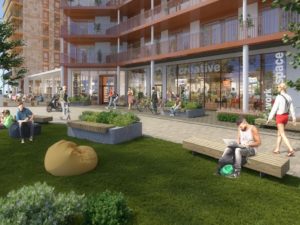Almost 100 business leaders wrestled with some of the issues around workspace at a big debate organised by the Brighton and Hove Chamber of Commerce this afternoon (Wednesday 6 July).
They listened and debated with an expert panel in the debate at City College Brighton and Hove, in Pelham Street, Brighton, chaired by the college’s chief executive Nick Juba.
The debate took place against the backdrop of the City Plan, a strategic blueprint drawn up by planners working for Brighton and Hove City Council.
The broad overview – City Plan Part 1 – was approved in March after years of work. The more detailed allocation of sites and land use – City Plan Part 2 – will look at things such as housing, leisure, shops, offices and tourism. That work is just getting under way.
Gayle Mann, from Entrepreneurial Spark, the free business accelerator hub for early stage and growing business, spoke about workspace and affordability.
Phil Jones, chief executive of Wired Sussex, the membership and support organisation for the digital sector, said that the sector was still growing at a double-digit rate.
Demand for space was biggest from firms with a turnover of between £1 million and £3 million but options were limited.
He said that estate agent Phil Graves estimated that the city had lost almost 750,000 sq ft of workspace partly because of changes to permitted development rights.
He said that while it was ok for disused factory space to be turned into housing in the north, here it was “the road to hell, paved with good intentions”.
Too many developers who come to the city have no idea about the city and what it’s about – or what the digital sector needs, such as short-term leases.
“They come here and they only have pound signs in their eyes,” he said. “We should resist their blandishments.”
Brighton-born and bred property agent Chris Oakley, who started out as an office agent, said that it was all about a sense of space and place.
In the 33 years he had spent in the profession, he said, everything had changed but nothing had changed, adding: “Brighton is a fantastic place to work. The demand exists. Why can’t create business space?”
Steve Pette – space needs have change. “With just a laptop and a mobile phone, you can start a global business. You can do more with less.”
Mr Pette praised the way that some banks were adapting to the new ways in which businesses were working.
Mike Hollingbery, director of creative digital agency Bozboz, said that his web design business had bought premises close to St Peter’s Church.
He said: “Over the past eight years we’ve grown a lot and had to move four times.”
He said that he felt that he had inadvertently become a property developer.
Former council leader Jason Kitcat, from Crunch accountants, spoke about the changes brought about by permitted development rights. He said: “Any offices vacated now can be turned into flats.”
Property owners can often double their money by selling homes rather than letting office space, he said.
Fast-growing Crunch had even looked at moving to the Gatwick and Crawley area because it had found it so hard to find premises locally.
But being in Brighton and Hove was one of its attractions when recruiting.
He said that Brighton and Hove had probably lost some poor office space – and he had seen some very poor office space – but the rules were now affecting the prospects for growing businesses.
The council won an exemption – known as an article 4 exemption – for part of the area which is still in force.
Planning policy officer Liz Hobden, who works for the council, explained some of the practical issues that prevented viable office development in the area.
She said asked for input as the council developed Part 2 of the City Plan and signalled a willingness to talk to those who could help build workspaces of the future.

In his introductory remarks Nick Juba said: “I saw a fantastic presentation at a meeting yesterday showing all of the current and planned developments taking place in the city – Circus Street, Churchill Square, Black Rock, the Seafront arches, University of Brighton, University of Sussex, Preston Barracks, the Marina.
“We have our own plans for the campus here at City College. This list goes on – and you can’t help but get a little bit excited about this amazing city that we live and work in and what it might look like in ten years’ time.
“One of the things that struck me was the emphasis that was put on establishing the city as a ‘magnet’ – as a destination – and the potential impact this might have on our population which is estimated to grow around 7 per cent in the city and by three quarters of a million across the Greater Brighton city region within ten years.
“This growth – welcome as it is – will, however, put pressure on the city’s infrastructure and much of the emphasis at the moment appears to be on housing.
“And you can see why, because the city’s assessed housing need is 30,120 by 2030. And yet even if we realise all the developments I mentioned above we will only build 13,200 or circa 45 per cent of the new homes required.
“The reason I raise this is that this will likely create even bigger pressures on good quality workspace.

“Is there a risk that in the legitimate drive to generate more housing we overlook the essential role that workspace has in driving economic growth and development? After all, people need somewhere to work, right?
“There are a whole range of issues that sit beneath the question of how we meet the demand for workspace in the city
- What do businesses want and need?
- What about the modern working style? Collaboration and networks? Can we learn from other cities?
- What’s the situation really like in Brighton? Is it full? Or is it just underutilised?
- Are there limited suitable buildings?
- What’s the answer?
- Do we need to look further afield? Can we move out? Are transport links preventing this?
“I suppose the point I am trying to make is that the issues – and therefore probably the solutions – facing workspace in the city are integrated and complex.”

He introduced development manager Eeva Paasiaro, from property business First Base, one of the firms behind new proposals for Anston House, the derelict office building opposite Preston Park.
She said that plans to transform the site, developed with Hyde Housing and designed by Conran and Partners architects, had been submitted to the council.
As well as 229 homes, the plans include the sort of flexible workspace that was spoken about during the debate. She urged people to look at the plans and give their feedback.












